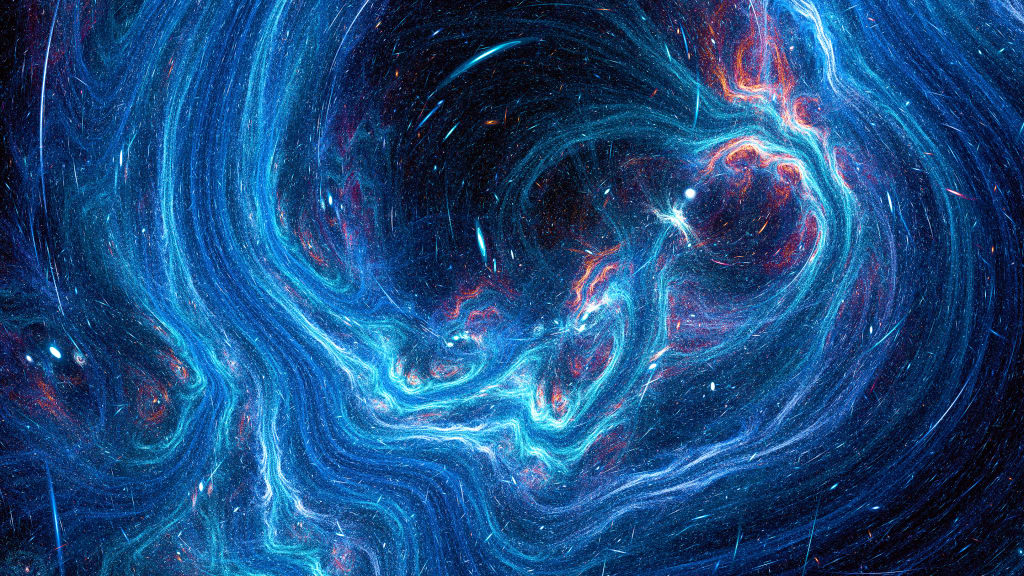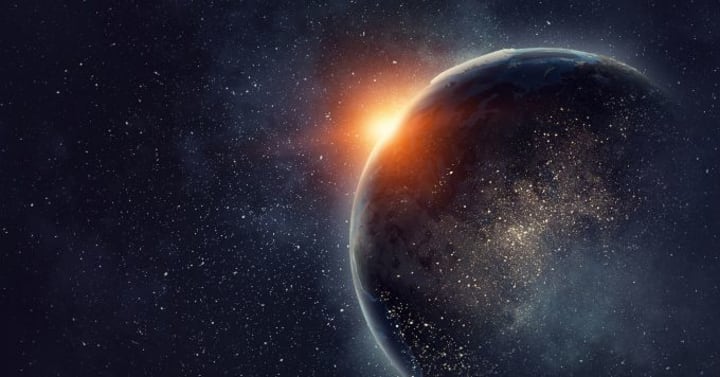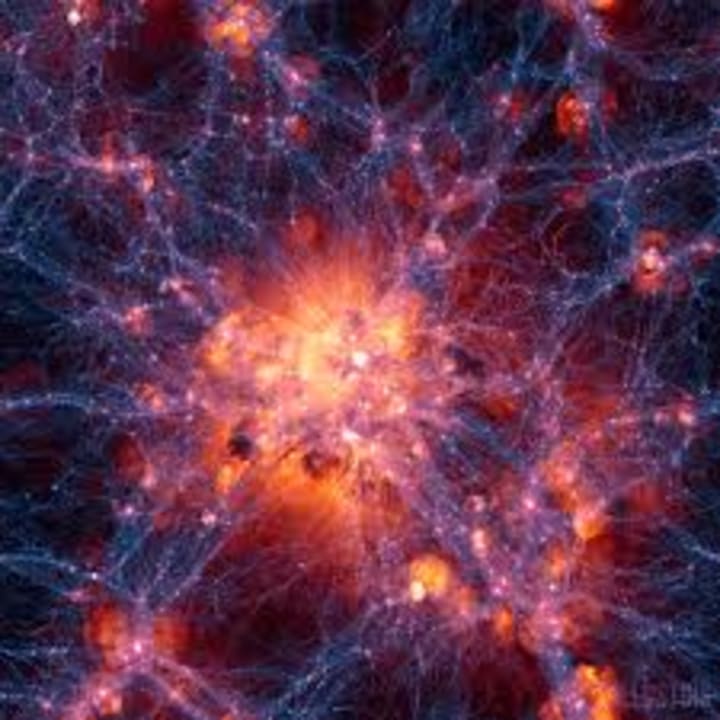
Did you know that
The earliest cosmological models of the universe were developed by ancient Greek and Indian philosophers and were geocentric, placing Earth at the center. Over the centuries, more precise astronomical observations led Nicolaus Copernicus to develop the heliocentric model with the Sun at the center of the Solar System. In developing the law of universal gravitation, Isaac Newton built upon Copernicus's work as well as Johannes Kepler's laws of planetary motion and observations by Tycho Brahe.

Further observational improvements led to the realization that the Sun is one of hundreds of billions of stars in the Milky Way, which is one of at least two trillion galaxies in the universe. Many of the stars in our galaxy have planets. At the largest scale, galaxies are distributed uniformly and the same in all directions, meaning that the universe has neither an edge nor a center. At smaller scales, galaxies are distributed in clusters and superclusters which form immense filaments and voids in space, creating a vast foam-like structure. Discoveries in the early 20th century have suggested that the universe had a beginning and that space has been expanding, since then and is currently still expanding at an increasing rate.
The Big Bang theory is the prevailing cosmological description of the development of the universe. According to estimation of this theory, space and time emerged together 13.799±0.021 billion years agoand the energy and matter initially present have become less dense as the universe expanded. After an initial accelerated expansion called the inflationary epoch at around 10−32 seconds, and the separation of the four known fundamental forces, the universe gradually cooled and continued to expand, allowing the first subatomic particles and simple atoms to form. Dark matter gradually gathered, forming a foam-like structure of filaments and voids under the influence of gravity. Giant clouds of hydrogen and helium were gradually drawn to the places where dark matter was most dense, forming the first galaxies, stars, and everything else seen today. It is possible to see objects that are now further away than 13.799 billion light-years because space itself has expanded, and it is still expanding today. This means that objects which are now up to 46.5 billion light-years away can still be seen in their distant past, because in the past, when their light was emitted, they were much closer to Earth.

From studying the movement of galaxies, it has been discovered that the universe contains much more matter than is accounted for by visible objects; stars, galaxies, nebulas and interstellar gas. This unseen matter is known as dark matte (dark means that there is a wide range of strong indirect evidence that it exists, but we have not yet detected it directly). The ΛCDM model is the most widely accepted model of our universe. It suggests that about 69.2%±1.2% [2015] of the mass and energy in the universe is a cosmological constant (or, in extensions to ΛCDM, other forms of dark energy, such as a scalar field) which is responsible for the current expansion of space, and about 25.8%±1.1% [2015] is dark matter. Ordinary ('baryonic') matter is therefore only 4.84%±0.1% of the physical universe. Stars, planets, and visible gas clouds only form about 6% of ordinary matter, or about 0.29% of the entire universe.

There are many competing hypotheses about the ultimate fate of the universe and about what, if anything, preceded the Big Bang, while other physicists and philosophers refuse to speculate, doubting that information about prior states will ever be accessible. Some physicists have suggested various multiverse hypotheses, in which our universe might be one among many universes that likewise exist.
The definition
The physical universe is defined as all of space and time[a] (collectively referred to as spacetime) and their contents. Such contents comprise all of energy in its various forms, including electromagnetic radiation and matter, and therefore planets, moons, stars, galaxies, and the contents of intergalactic space. The universe also includes the physical laws that influence energy and matter, such as conservation laws, classical mechanics, and relativity.

The universe is often defined as "the totality of existence", or everything that exists, everything that has existed, and everything that will exist.[26] In fact, some philosophers and scientists support the inclusion of ideas and abstract concepts—such as mathematics and logic—in the definition of the universe. The word universe may also refer to concepts such as the cosmos, the world, and nature.
WOf the four fundamental interactions, gravitation is the dominant at astronomical length scales. Gravity's effects are cumulative; by contrast, the effects of positive and negative charges tend to cancel one another, making electromagnetism relatively insignificant on astronomical length scales. The remaining two interactions, the weak and strong nuclear forces, decline very rapidly with distance; their effects are confined mainly to sub-atomic length scales.
The universe appears to have much more matter than antimatter, an asymmetry possibly related to the CP violation.[45] This imbalance between matter and antimatter is partially responsible for the existence of all matter existing today, since matter and antimatter, if equally produced at the Big Bang, would have completely annihilated each other and left only photons as a result of their interaction.[46][47] The universe also appears to have neither net momentum nor angular momentum, which follows accepted physical laws if the universe is finite. These laws are Gauss's law and the non-divergence of the stress-energy-momentum pseudotensor.[48]
Constituent spatial scales of the observable universe
Location of Earth (3x3-English Annot-smaller).png
This diagram shows Earth's location in the universe on increasingly larger scales. The images, labeled along their left edge, increase in size from left to right, then from top to bottom.
Size and regions
See also: Observable universe and Observational cosmology
Television signals broadcast from Earth will never reach the edges of this image.
The size of the universe is somewhat difficult to define. According to the general theory of relativity, far regions of space may never interact with ours even in the lifetime of the universe due to the finite speed of light and the ongoing expansion of space. For example, radio messages sent from Earth may never reach some regions of space, even if the universe were to exist forever: space may expand faster than light can traverse it.[49]
Distant regions of space are assumed to exist and to be part of reality as much as we are, even though we can never interact with them. The spatial region that we can affect and be affected by is the observable universe. The observable universe depends on the location of the observer. By traveling, an observer can come into contact with a greater region of spacetime than an observer who remains still. Nevertheless, even the most rapid traveler will not be able to interact with all of space. Typically, the observable universe is taken to mean the portion of the universe that is observable from our vantage point in the Milky Way.
The proper distance—the distance as would be measured at a specific time, including the present—between Earth and the edge of the observable universe is 46 billion light-years[50] (14 billion parsecs),[51] making the diameter of the observable universe about 93 billion light-years (28 billion parsecs).[50] The distance the light from the edge of the observable universe has travelled is very close to the age of the universe times the speed of light, 13.8 billion light-years (4.2×109 pc), but this does not represent the distance at any given time because the edge of the observable universe and the Earth have since moved further apart.[52] For comparison, the diameter of a typical galaxy is 30,000 light-years (9,198 parsecs), and the typical distance between two neighboring galaxies is 3 million light-years (919.8 kiloparsecs).[53] As an example, the Milky Way is roughly 100,000–180,000 light-years in diameter,[54][55] and the nearest sister galaxy to the Milky Way, the Andromeda Galaxy, is located roughly 2.5 million light-years away.[56]

Because we cannot observe space beyond the edge of the observable universe, it is unknown whether the size of the universe in its totality is finite or infinite.[3][57][58] Estimates suggest that the whole universe, if finite, must be more than 250 times larger than the observable universe.[59] Some disputed[60] estimates for the total size of the universe, if finite, reach as high as {\displaystyle 10^{10^{10^{122}}}}10^{1megaparsecs, as implied by a suggested resolution of the No-Boundary Proposal.[61][b]
Age and expansion
Main articles: Age of the universe and Metric expansion of space
Astronomers calculate the age of the universe by assuming that the Lambda-CDM model accurately describes the evolution of the Universe from a very uniform, hot, dense primordial state to its present state and measuring the cosmological parameters which constitute the model.[citation needed] This model is well understood theoretically and supported by recent high-precision astronomical observations such as WMAP and Planck.[citation needed] Commonly, the set of observations fitted includes the cosmic microwave background anisotropy, the brightness/redshift relation for Type Ia supernovae, and large-scale galaxy clustering including the baryon acoustic oscillation feature.[citation needed] Other observations, such as the Hubble constant, the abundance of galaxy clusters, weak gravitational lensing and globular cluster ages, are generally consistent with these, providing a check of the model, but are less accurately measured at present.[citation needed] Assuming that the Lambda-CDM model is correct, the measurements of the parameters using a variety of techniques by numerous experiments yield a best value of the age of the universe as of 2015 of 13.799 ± 0.021 billion years.
Astronomers have discovered stars in the Milky Way galaxy that are almost 13.6 billion years old.
Over time, the universe and its contents have evolved; for example, the relative population of quasars and galaxies has changed[62] and space itself has expanded. Due to this expansion, scientists on Earth can observe the light from a galaxy 30 billion light-years away even though that light has traveled for only 13 billion years; the very space between them has expanded. This expansion is consistent with the observation that the light from distant galaxies has been redshifted; the photons emitted have been stretched to longer wavelengths and lower frequency during their journey. Analyses of Type Ia supernovae indicate that the spatial expansion is accelerating.[63][64]
The more matter there is in the universe, the stronger the mutual gravitational pull of the matter. If the universe were too dense then it would re-collapse into a gravitational singularity. However, if the universe contained too little matter then the self-gravity would be too weak for astronomical structures, like galaxies or planets, to form. Since the Big Bang, the universe has expanded monotonically. Perhaps unsurprisingly, our universe has just the right mass-energy density, equivalent to about 5 protons per cubic metre, which has allowed it to expand for the last 13.8 billion years, giving time to form the universe as observed today.[65]
There are dynamical forces acting on the particles in the universe which affect the expansion rate. Before 1998, it was expected that the expansion rate would be decreasing as time went on due to the influence of gravitational interactions in the universe; and thus there is an additional observable quantity in the universe called the deceleration parameter, which most cosmologists expected to be positive and related to the matter density of the universe. In 1998, the deceleration parameter was measured by two different groups to be negative, approximately -0.55, which technically implies that the second derivative of the cosmic scale factor has been positive in the last 5-6 billion years. This acceleration does not, however, imply that the Hubble parameter is currently increasing; see deceleration parameter for details.
Spacetime
Main articles: Spacetime and World line
See also: Lorentz transformation
Spacetimes are the arenas in which all physical events take place. The basic elements of spacetimes are events. In any given spacetime, an event is defined as a unique position at a unique time. A spacetime is the union of all events (in the same way that a line is the union of all of its points), formally organized into a manifold.
Events, such as matter and energy, bend spacetime. Curved spacetime, on the other hand, forces matter and energy to behave in a certain way. There is no point in considering one without the other.
The universe appears to be a smooth spacetime continuum consisting of three spatial dimensions and one temporal (time) dimension (an event in the spacetime of the physical universe can therefore be identified by a set of four coordinates: (x, y, z, t) ). On average, space is observed to be very nearly flat (with a curvature close to zero), meaning that Euclidean geometry is empirically true with high accuracy throughout most of the Universe. Spacetime also appears to have a simply connected topology, in analogy with a sphere, at least on the length-scale of the observable universe. However, present observations cannot exclude the possibilities that the universe has more dimensions (which is postulated by theories such as the string theory) and that its spacetime may have a multiply connected global topology, in analogy with the cylindrical or toroidal topologies of two-dimensional spaces. The spacetime of the universe is usually interpreted from a Euclidean perspective, with space as consisting of three dimensions, and time as consisting of one dimension, the "fourth dimension". By combining space and time into a single manifold called Minkowski space, physicists have simplified a large number of physical theories, as well as described in a more uniform way the workings of the universe at both the supergalactic and subatomic levels.
Spacetime events are not absolutely defined spatially and temporally but rather are known to be relative to the motion of an observer. Minkowski space approximates the universe without gravity; the pseudo-Riemannian manifolds of general relativity describe spacetime with matter and gravity.
Shape
Main article: Shape of the universe
The three possible options for the shape of the universe
General relativity describes how spacetime is curved and bent by mass and energy (gravity). The topology or geometry of the universe includes both local geometry in the observable universe and global geometry. Cosmologists often work with a given space-like slice of spacetime called the comoving coordinates. The section of spacetime which can be observed is the backward light cone, which delimits the cosmological horizon. The cosmological horizon (also called the particle horizon or the light horizon) is the maximum distance from which particles can have traveled to the observer in the age of the universe. This horizon represents the boundary between the observable and the unobservable regions of the universe.The existence, properties, and significance of a cosmological horizon depend on the particular cosmological model.
An important parameter determining the future evolution of the universe theory is the density parameter, Omega (Ω), defined as the average matter density of the universe divided by a critical value of that density. This selects one of three possible geometries depending on whether Ω is equal to, less than, or greater than 1. These are called, respectively, the flat, open and closed universes
Observations, including the Cosmic Background Explorer (COBE), Wilkinson Microwave Anisotropy Probe (WMAP), and Planck maps of the CMB, suggest that the universe is infinite in extent with a finite age, as described by the Friedmann–Lemaître–Robertson–Walker (FLRW) models. These FLRW models thus support inflationary models and the standard model of cosmology, describing a flat, homogeneous universe presently dominated by dark matter and dark energy.
Support of life
Main article: Fine-tuned universe
The universe may be fine-tuned; the Fine-tuned universe hypothesis is the proposition that the conditions that allow the existence of observable life in the universe can only occur when certain universal fundamental physical constants lie within a very narrow range of values, so that if any of several fundamental constants were only slightly different, the universe would have been unlikely to be conducive to the establishment and development of matter, astronomical structures, elemental diversity, or life as it is understood. The proposition is discussed among philosophers, scientists, theologians, and proponents of creationism.

.
About the Creator
Liam S Crawford
We believe that music has the power to bring people together and evoke strong emotions, and we want to share that with you. come join us on our musical journey. Let the music speak for itself!
Enjoyed the story? Support the Creator.
Subscribe for free to receive all their stories in your feed. You could also pledge your support or give them a one-off tip, letting them know you appreciate their work.






Comments
There are no comments for this story
Be the first to respond and start the conversation.